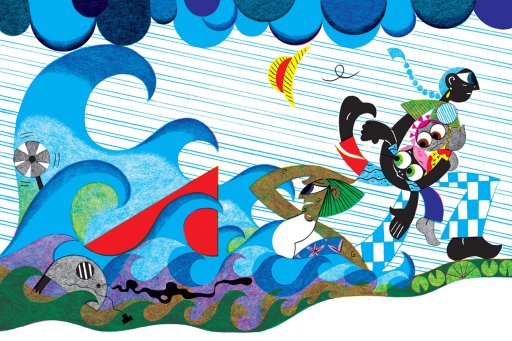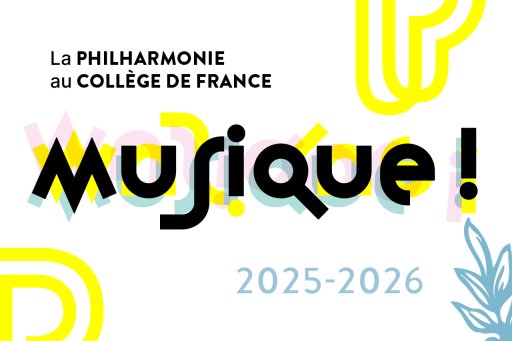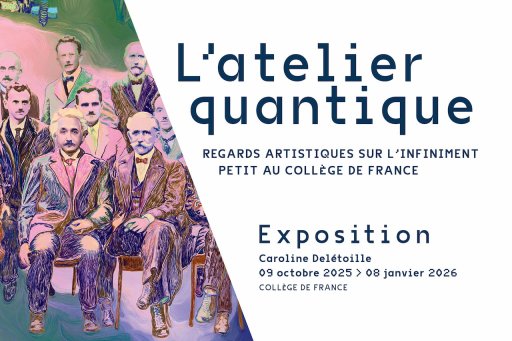Transcription de la vidéo (en anglais)
Alain Prochiantz (AP) : Pourquoi est-ce que Tony Cragg est au Collège de France ? Parce que je connaissais Tony Cragg depuis longtemps, il avait fait une exposition à Beaubourg il y a une vingtaine d’années, il avait lu des choses de moi, je ne sais pas pourquoi d’ailleurs, c’est ahurissant. Il avait demandé que je vienne discuter avec lui sur les questions de formes puisque comme vous le savez je suis morpho-généticien, je m’occupe de la création et de l’évolution des formes, et quand on regarde ses statues, il y a quelque chose qui s’apparente à la sécrétion, il y a de la matière, de la forme. Cela l’amusait de confronter un scientifique avec un artiste sur une question qui pourrait être – non pas le même objet, certainement pas le même objet, parce que la science et l’art sont deux choses complètement différentes – mais voir si on peut faire de la science poétiquement modifiée à travers une réflexion sur l’art qui serait celle de Tony en l’occurrence.
AP: I was saying that Science and Art have nothing to do together, more or less. Mind the gap. Nor bridge the gap, but mind the gap. But we can dream together, which it’s different.
Tony Cragg (TC): Alain is right. Apparently there is an enormous gap between Science and Art, at the present time. It’s not always been the case because there was no term for Science and Art 500 years ago. It was more or less the same thing, and this because the specialist knowledge that has been necessary for science has diverged increasingly over the last centuries and seems to be parting completely. On the other hand, we both get all of our knowledge from looking at material and that’s not surprising because everything we see around us is made of material, or is phenomena. We are made of material and even if you push it to a sort of limit, which I think I have to be consequent about it, our intelligence, our thoughts and our emotions are also phenomena of the material. Alain is looking at it from a neurological point of view, but I’m looking at it from the surface because all I’m left is, as most people in the population, that’s what we see. We see the material because of the light reflected by its surface. That’s all we have. We are always using our mind to go underneath beyond that surface. We look at the face, this is very interesting, but I want to know what is behind that face. So, that’s not a scientific investigation, that’s something about getting to know things on a different level.
AP: What he is looking for, as I understand it, I might be totally wrong, I’m not an artist as you know… What is more interesting than the shape is the invisible behind the visible. When I look at things like that, as a scientist, I have to look at the invisible just behind what is obvious. So we are not so much interested by the shapes, but by what is shaping the object: how it develops, how it can be transformed, what is the physiological meaning of this changes, the logic of life for example, if there is any logic to this thing. Which is extremely different from what an artist would do. The artist will be more on the emotional “facette” of this work. There is no bridge between us, there is a huge gap, except if we go to the level of what thinking means. This is the most interesting part when we try to mind the gap between science and art : what is creativity, what is the role of language, what is the part of the invisible in what we do. Because we are human beings, any good things built in art or science is individual, it’s someone who’s doing it. It has to do with our own language. A great artist or a great scientist or a great writer is someone that advances his own language in many ways. That’s what can allow us to discuss. It’s the basis for discussion. Beyond that, we are not doing the same thing at all. He can take what I do and use it as a material for his work, he’s going to make my science poetic but then it’s not science anymore. I’m working with someone who’s doing theatre, Jean-François Peyret, I would be writing scientific stuff for him, he takes them, he puts them into the mouth of actors, it goes on stage and it’s not science anymore. It becomes poetry and that’s totally different. I don’t want to bridge the gap.
TC: It’s important we don’t. But I have to say that we are made of material, material has created us, material has taught us to think and material teaches us language. Every term we have and therefore every idea, everything going on in our brain has come from outside. Science is the clever way of using materials.
AP: Not always!
TC: It’s the clever way of our strategy to use materials in the world. Artists sometimes get into a position to tell us what gives perspective on that, what it means. They can say: those two galaxies will collide together. This is a fantastic, abstract notion. And the scientists are always pouring out those incredible pieces of information about our reality. How do we get that in our heads? Who provides images for that at the end of it, a priori, but even going into those situations? I have to say, and that’s probably not something a scientist can agree with, but it is very often that artists went to the moon before the scientists got there. The artists thought about transmigration, about lots of different things and forms of society. Lots of things come out of a sort of an artistic point of view because they don’t have to be realized, they don’t have to function, they can just throw up all the options. In the end, a more rational person with more knowledge will then decide the course of history.
AP: The first planes we have fabricated in 1903-1904, we were just flying like that at one meter from the ground and 60 years later you are on the moon, not by thought, but really on the moon. This is really a big jump and this is poetic. If this isn’t poetic, what is poetry? I think science can really be poetic by this way. 60 years, can you imagine that?
TC: We have to understand what we are both saying, using this word: poetic. Poetic is from the Greek “poesis” and it just means : to create with material, the creation of things. And so that’s why a scientist can say that and I think that’s a clear statement « that is poetic » but I feel the art in the last 60 years has just changed incredibly in so many different ways on the subjects on what is going on into society, the way it functions, the way images had been produced.
AP: It has changed because the materials have changed?
TC: Look at sculpture. End of the 19th century, it was all figurative, made of about 4 or 5 materials, stone, wood, plaster, whatever. With the efforts of certain artists, Russell, Duchamp, Brancusi, Rodtchenko, and then expending. Now it’s a study of the meaning of all materials in the world. Artists use from DNA to gold to shit, everything that comes up, there’s no meaning of that material. We are talking about sexuality, about social relationships, about political meanings, about the environment, that wasn’t a subject in art in such an open way. It’s relevant to society, it has increased incredibly as well. Art seeps into society, it’s changing attitudes.
AP: Science is so logic, in a way that you think you can get all the information and if you had a way to classify it with a very big computer you could create knowledge. The question is: is it true? Or isn’t it true? If you take Darwin for example, let’s go back to the basics, and all the information Darwin has gathered for 30 years, sailing and collecting and writing notes to his colleagues and getting all those little notes that he had in his house, he has made sense of it and developed the theory of evolution basically because he has red Malthus. If you take all this information that he had and you imagine a big computer, you could put the information in the computer. What comes out of the computer? Is it the theory of evolution that Darwin provided or is it something totally different? It would be a very nice experiment to do. It raises the issue of what is the role of the human being Darwin. His imagination? His thoughts? His psychology? The fact is that he has been able to take all this things and provide biology with the only theory we have at this point. The only point where we could really try to see whether there is something common between an artist and a scientist and when it comes to what is unique to the person who is doing it.
TC: I’d just like to stake perhaps a different aspect. Going to Darwin for example who is a classic case of something that is constant in our every day life. Through knowledge he challenged what people believed because scientists are interested in knowledge but the other thing that actually plays one of the biggest roles in our lives is belief. Whoever you are, a great scientist or just somebody on the street, we all know something, that’s probably not very much but beyond the arise of what we think we know, there’s an enormous area of things we don’t know and we have to believe. And belief is a great part of our lives. Artists participate because belief becomes subjective, it has to be, because not based on objectivity. So, working in that area of belief is something that’s an enormous role for literature, for all areas of art. I think that’s one of the most fundamental things that artists do.
AP: there’s an art of believing in nothing.
TC: Exactly! It’s frightening.
AP: and to live anyhow. This is really what we should achieve. The scientist should believe in nothing, not even in what he does.
TC: But for most people it’s a frightening consequence because if you just say : give us another couple of millennia and probably the moon could drift away, there will be no sun, no life left on the planet, we didn’t manage to get to another galaxy... So what happens? We came here, we did all this and we just disappear.
AP: It is meaningless.
TC: So, does it mean nothing at all?
AP: Yes, we have to be beckettian as scientists.
TC: Yes but that’s the biggest consequence. If you take a materialist attitude and you follow science, you may end up at that conclusion. But still, while we’re here, it’s a little pocket of existence that… If we don’t do it for anything else in the all-wild universe, in the multiverse, we should do a good job.
AP: Enjoy it at least.
TC: Exactly. So we’re back to your friend Marquis de Sade.
TC: One of the great things that sculpture does, it’s a very small category of objects in the world. It doesn’t belong to Nature and it doesn’t belong to our mankind’s normal usage of material, in a utilitarian sense. Because utilitarianism makes the material use certain very limited common denominated decision making processes, it becomes very low level, relatively boring to be honest, relatively meaningless, we’re in the process of impoverishing the all of the forms on our planet. And it’s my belief that sculpture is a way of developing forms that act against this impoverishment, the general tendencies that we have in making things. That’s all my work is about.










